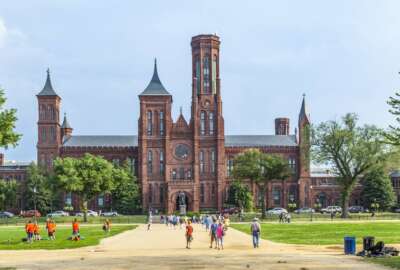Homeland Security returns money to a state hosting a spiffy new lab
The new National Bio and Agro-Defense facility came in under budget, which has produced a sort of financial echo.
The Department of Homeland Security last year completed a big project in Manhattan — Manhattan, Kansas, that is. Construction finished, the Science and Technology directorate cut the ribbon to the National Bio and Agro-Defense (NBAD) Facility there. And it came in under budget, which has produced a sort of financial echo. For a review of what it is and why its important, National Bio and Agro Defense Facility Program Manager Tim Barr joins the Federal Drive with Tom Temin.
Transcript interview:
Tom Temin
We’ll get into why you’re the former in just a moment. But first, I think the latest development in this project is that a bunch of money came back from the federal government to the state of Kansas over this. Tell us what that’s all about.Tim Barr
So when the program was started, way back in 2006 — it’s been going on a long time — when we put out an RFI for different sites to do it. One of the things was if different entities who want to have this in their location, you can provide funding, you can provide land, whatever, there’s no restrictions on that. It wasn’t a requirement. But you could do it. So long story short, the state of Kansas gave us the 48 acre site. But they also gave us in total $307 million to go towards the construction of the $1.25 billion facility, with the stipulation that any funds remaining at the end of the project would be returned. Well, as things turned out, we had money leftover. So think it’s been a couple of weeks, now we wired the state of Kansas’ treasurer $10,082,355.80 That’s how much we are under budget on a $1.25 billion project. That’s the short story, Tom.Tom Temin
Wow, I would have thrown in maybe a couple of dimes to round up that 80 cents to an even number. But we referred to you a moment ago as the former National Bio and Agro Defense Facility manager. It’s no longer Homeland Security?Tim Barr
The U.S. Department of Agriculture owns and operates the facility. So this facility replaces the existing research facility at Plum Island, which is on an island between New York, Long Island and Connecticut. And the mission there will be the same mission at NBAD. Although slightly expanded, to do comprehensive research, develop vaccines, antivirals, and diagnostics and training capabilities to protect the country from foreign animal and emerging diseases that could impact our food supply and the ag economy. The difference with NBAD is in addition to the capabilities that currently exist at Plum Island, NBAD will have a BSL4 capability, which is the only facility in the United States that has BSL4 capability for large animals.Tom Temin
BSL4 means…?Tim Barr
So BSL2 is like a college chemistry lab, I’ll say. BSL3 is you’re working on pathogens for which there’s no impact on humans or there are known and standard treatments for humans dealing with them. BSL4, you’re working on things for which there is no treatment. And basically the work is you’re working in a moon suit with an air supply, things like Hendra virus, Ebola, things like that.Tom Temin
And this is located in Manhattan, Kansas; is it associated with the land grant university there?Tim Barr
It is adjacent to, it is not part of the university. But originally, DHS initiated the program. There’s USDA employees at Plum Island. In fact, the bulk of the employees there are USDA employees, they do the bulk of the research. And so when we were programming to get NBAD going, clearly we got a lot of input from USDA on their needs and all that, but DHS was going to be the owner-operator as they are with the Plum Island facility. The President’s budget in 2019 proposed, ‘let’s switch this over to have it USDA operated;’ that got enacted when the budget was put in place. And so we had to collaborate even more closely with USDA to change the management posture on all that. But in that, the legislation also stipulated that DHS would complete the — ongoing, at that time — construction and commissioning of the facility. So, now that that’s done, that’s why I’m now the former program manager for the NBAD program for Homeland Security.Tom Temin
We’re speaking with Tim Barr, that former program manager. What are you program manager of now by the way?Tim Barr
I’m not a program manager. I’m currently functioning as an advisor within the Office of National Labs, Science and Technology Directorate, supporting various program initiatives.Tom Temin
And let’s get back to Plum Island now. You say that still is DHS, but that is slated to close?Tim Barr
Yes. As you mentioned earlier, we had the ribbon cutting which was sponsored by USDA and they did a great job, had a lot of nice dignitaries there, it was a great event. Very fulfilling at the end of a long, long period of execution. So right now they’re in the process of executing their plan to move all the pathogens from Plum Island to NBAD, which, I don’t know the details on that, I’m not involved in that anymore. But that’s ongoing right now. Once they get all those there, then they can start to take over the capabilities that are currently ongoing at Plum Island. Once that’s done, then the research facilities at Plum Island will be decommissioned and the property dispositioned, which is a changing avenue.Tom Temin
Sure. Well, let’s hope they don’t spill anything along the way, taking it from Plum Island to Kansas.Tim Barr
There are tried and true methods for moving materials such as that.Tom Temin
And what’s required to decommission a place that was full of, frankly, poisons and unknown pathogens or untreatable pathogens for so many decades. That really goes back, I think, to World War II.Tim Barr
The decommissioning of Plum Island is something I’m not completely familiar with. There’s another program area within the organization that’s dealing with that. But one point is that the untreatable pathogens you mentioned, that you have in a BSL4, they are not on Plum Island. Plum Island does not have the BSL4 capability. Their highest level is the BSL3.Tom Temin
Right. So they could decommission that with some reasonable assurance that they could put up condos.Tim Barr
Yeah, that plan’s in place. I am just not intimately familiar with it in order to speak to the various details.Tom Temin
All right, and maybe just review for us, in some more detail, what does go on now that will happen in the new place in Manhattan? Is it mostly federally staffed? Or do academic researchers come in? Or how does that work?Tim Barr
USDA uses basically a government-owned, government-operated approach with all federal employees. They do have some contractor support in certain areas. But they do partner. So all the research is basically done by those federal employees. And they do — as does DHS — reach out to various partners around the country and around the world in some ways, just for collaborations. But of the, I think the facility will employ something like 400 people, the bulk of those being federal employees, and they’re the ones that do the research there. And there’s research, and then there’s also the diagnostic mission, that’s a big part of the NBAD mission. And training: You bring in veterinarians from around the country, from around the world. And you show them ‘here’s what this disease looks like in these various animals,’ which is very valuable, because now these veterinarians are out in the field. And they can understand, ‘Okay, I’ve seen this before. I was trained on this,’ and so on. So that’s a big part of the mission as well.Tom Temin
All right, sounds like a new twist on dog and pony show the way those veterinarians go out there. And Science and Technology Directorate, I think of that as the applied science wing, if you will, for Homeland Security, and its various missions. With the expelling of the new facility, the NBAD to Agriculture, what will Science and Technology at DHS continued to do in the bio defense area, which is still a legitimate concern for Homeland Security?Tim Barr
So Science and Technology will still have a role in the Ag defense bio world. We’re still discussing with USDA how our partnership’s exactly going to work when that facility’s up and running. But we have other avenues to meet our mission needs at other facilities around the country. Not like NBAD, per se. But I would also point out that the Ag defense mission in Science and Technology is not the bulk of the work that Science and Technology does. There are many, many, many other areas of of research beyond the animal health and Ag defense mission functions that Science and Technology works on.Tom Temin
Homeland Security operates in pretty much every area of infrastructure, fair to say. All right. So what will you do next year — you’ve been sort of kicked out to advisory role but sounds like you’ve been there a long time?Tim Barr
Yes. Well, so I reside in Manhattan, Kansas. I’m now a remote employee in Manhattan, Kansas supporting the headquarters organization. And I’m enjoying that; it’s nice to do something new. I moved here to Manhattan in January of 2011. Back when the site was basically a pile of dirt. So while it’s very, very fulfilling to have completed that facility successfully, gotten it commissioned. And on top of that, as a native Kansan, being able to send money back to the state of Kansas. I’m enjoying the new role of diving into some different things for a change.Tom Temin
And for those that have not had the pleasure of visiting Manhattan, Kansas, which the Northeast Corridor train does not go to, what are some of the virtues of Manhattan, Kansas?Tim Barr
Well, so it’s a town of about 50,000. University Town, Kansas State University is located here, which is also where I went to school. And it’s a nice little Midwestern town with a nice share of brew pubs and nice restaurants and different things to do. And it’s not too far from Kansas City. It’s not a drive in traffic to Kansas City. It’s a straight hour and a half, two hour, get in your car and go and you’re there.Tom Temin
Except no locality pay probably.Tim Barr
No.Tom Temin
Well, if there’s a brew pub locality pay won’t be far behind.
Copyright © 2024 Federal News Network. All rights reserved. This website is not intended for users located within the European Economic Area.
Tom Temin is host of the Federal Drive and has been providing insight on federal technology and management issues for more than 30 years.
Follow @tteminWFED






